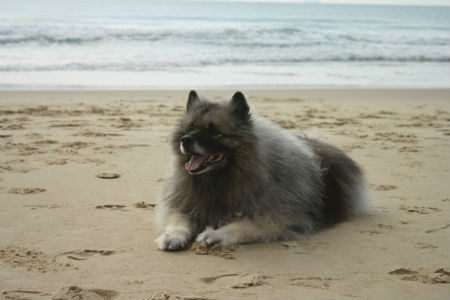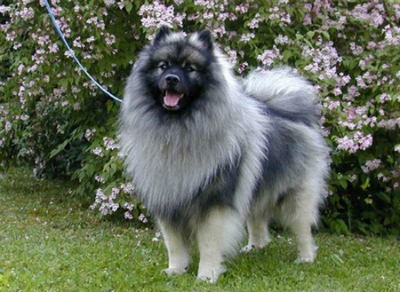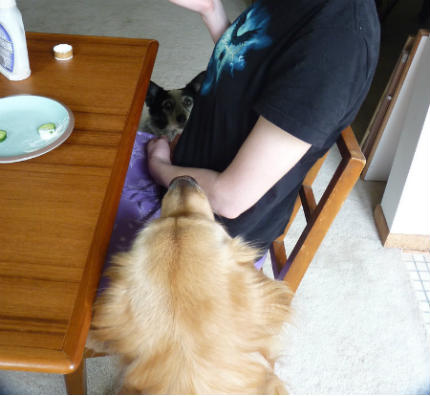In this installment we will dedicate ourselves to introducing you
to a breed of dog that is unusual , little known, but those who adopt them have in them a jovial, affectionate, faithful and very vigilant friend of their family. This is the
Keeshond .
-
Medium size .
-
Weight : Between 14 and 18kg.
-
Hair type : Long and dense.
-
Character : Cheerful, Playful, Agile, Obedient.
-
Health : Healthy
-
Life expectancy : Between 13 and 15 years.
In this installment we will dedicate ourselves to introducing you
to a breed of dog that is unusual , little known, but those who adopt them have in them a jovial, affectionate, faithful and very vigilant friend of their family. This is the
Keeshond .
The Keeshond or “people's dog”
Our dogs are part of the joy of the home, and
choosing a Keeshond as a pet is a good option . I invite you to continue with us to learn more about them.
Dog breeds are very varied, from the loudest and smallest to the quietest and largest, these animals have accompanied humans since ancient times. Dogs have been companion animals, hunters, or watchmen and protectors of the houses in which they live, becoming an important part of many family units. In this post we are going to tell you what Keeshond dogs are like.
It looks like a teddy
The Keeshond is a medium breed dog, with a double coat and a tender appearance that makes it look like a stuffed toy. He has an elegant bearing and is very agile and affectionate.
Its origin and history
Until 1926 it was called Wolfspitz , or wolf-type spitz. It is part of the classification of German spitz dogs, such as the large spitz, the medium spitz, the dwarf spitz and the Pomeranian, its closest relative. It is said that it originated in Germany, but now there are experts who consider it
to originate from the Kingdom of the Netherlands , that is, it is a fellow native of Holland.
The Keeshond is a long-established breed, said to have been used for centuries as a family companion and guardian. The Keeshond could be found living on some farms or boats in Holland, where they protected their masters from vermin, and also provided faithful company. Having lived in Holland for a long time, the Keeshond became a symbol of the Patriotic Holidays of the 17th century. Kees de Gyselaer, leader of that group, assigned the name "Kees'dog" to the breed, which in Dutch translates to "
kees hund ." The original Keeshond may have descended from the Arctic strain that gave rise to the Samoyed breed, the Norwegian hound and the Spitz. But its sweetness and devotion tell us that it has never been considered a hunting dog, but rather a companion dog.
Characteristics
Physical
Keeshond are medium-sized dogs , males measure 45 to 55 cm and can weigh between 25 to 35 kg. Females are generally smaller and lighter, about 43 to 45 cm in size and up to 25 kg. The shape of their heads is wedge-shaped and they have a small, rounded, black nose. The Keeshond's tail is medium in size with abundant, bushy hair curled over its back, which makes them look very elegant. The Keeshond has elongated eyes, very small and oblique, which resemble those of the wolf. Their ears are medium and erect, located on top of the head, triangular in shape, also similar to those of wolves.
The Keeshond has an abundant, soft, long and smooth double coat . The inner coat of hair is a pale gray or cream color, and the outer coat covers the inner hair, being a mixture of black and gray with black tips, which appears grayish like that of a wolf, hence the name
Wolfspitz . Due to the amount of hair, its legs seem very short for its size, but it is just a visual effect. The Keeshond is well proportioned, having a strong chest and a rather short abdomen. They easily adapt to the cold due to the characteristics of their fur, so they can be outside the house, but with shelter. On the contrary, they are not recommended for hot and humid climates.
Personality
The Keeshond is a characteristically guard dog, warning its family of anything it considers adverse.
He is very friendly , he likes company, he is happy and affectionate (he is often called "smiling Dutchman"). They demand a lot of affection and prefer to be inside the home than to stay outside.
He is very intelligent and easy to train , and he is also very playful.
Behavior
Being a purely guard dog,
the Keeshond will always be alert , which is why it can bark frequently; although they very rarely bite and, if people are accepted into their home, they will behave friendly and affectionate. Keeshonds
are very intelligent dogs, they learn quickly, and they can follow commands, but they often behave stubbornly. You must be patient and treat it with great affection.
Feeding
You must be careful with feeding these animals, because
they are prone to gaining weight and can frequently develop skin problems. The Keeshond always requires an excellent quality diet, with the right amount and taking care that it is in accordance with the daily exercise time he performs.
Health
These
are dogs that enjoy excellent health , they do not usually present hereditary diseases. But, they could suffer from epilepsy problems, hip dysplasia and, eventually, skin problems. You must maintain their veterinary control to keep them healthy.
One of the cares you must take is with the dental health of this and all dog breeds. Be careful to
maintain adequate dental hygiene , to prevent them from accumulating bacteria that could cause diseases.
Life expectancy
This breed of dog, with basic care and having them in a home that gives them the affection they need, can live 13 to 15 years.
Specific care
The care of this breed is similar to that of others of its size, here we tell you the basics you need to know about
the specific care of the Keeshond :
- Maintaining the coat of these pets will take up a lot of your time, because you will have to brush it about three or four times a week , and if it is the shedding season, it will have to be daily. Since the hair is fine and straight along with its undercoat that is very woolly, you have to take great care of it or it will form knots that are impossible to remove.
- As for exercise, the Keeshond is a fairly active dog , but they do not require a lot of exercise time. It is enough to take him for a walk twice a day and do activities with his family, like most dogs.
- They tend to adjust to living in small apartments . But if you have a backyard where he can run around, he will be even happier!
- Because of their thick fur, they live very well in cold climates, but hot climates can cause problems.
- Regarding training, like other dogs, Keeshonds need to be trained and socialized from an early age and constantly.
Some curious facts about the Keeshond
Our dog friends, depending on their breed, have certain peculiarities. In the case of the Keeshond dog breed, we can tell you the following curiosities:
- Every 6 months, for about 3 weeks, the Keeshond sheds its hair completely .
- Because of his thick tunic full of fur, we see Keeshond as larger than he really is.
- It's a square dog! The Keeshond is a dog that is as tall as it is long, and that gives it that look.
- It's a masked dog. A characteristic that makes the Keeshond easy to recognize is the kind of mask that covers part of its face , from the outside of its eyes to the corner of its ears.
- Gray is the official color of the Keeshond breed.
- He looks like a lion cub. Due to its very thick fur on its neck, added to the fact that it is double-layered, it makes it look like a small lion.
General analysis of this breed
The Keeshond are dogs that
were originally used primarily as a breed of working dog , functioning as watchmen on boats, with tasks of hunting vermin that sometimes got on the ships. At the end of the 19th century,
the Keeshond breed almost became extinct because boats were no longer used, although it managed to survive by beginning surveillance and protection work on the farms of the people who had adopted them. Some examples of Keeshond dogs were transported from their native Holland to England, although in the United Kingdom at that time they were not very popular. It was in 1920 when, upon arriving in the United States, this breed gained great importance.
They were finally recognized
By the year 1930, our friends the Keeshond became famous, having a boost in popularity, since
they were recognized as companion dogs by the prestigious American Kennel Club. Although it does not have the fame of other breeds, the Keeshond breed dog is excellent as a companion because it is easy to handle and has a medium size, which makes it easy to adapt to small places.
Despite this, the Keeshond is an animal that, having its origins in very cold places, does not tolerate high temperatures, which is why it is recommended for temperate and cold climates. They tend to be
very calm dogs without showing aggression towards humans or other animals. This changes when he feels that his family or home are threatened, precisely because of his protective instinct.
The Keeshond as a pet
If we choose a Keeshond as a pet, we must take into account that each breed of dog has its characteristic traits, and some may be inappropriate for the type of home we have or the climate of the city in which we live. Although the Keeshond dog breed adapts easily to almost any size home, we have to be aware that they need a certain amount of daily exercise and adequate nutrition. You must always be attentive to training him from a puppy and constantly reinforcing his education or he will cause problems in the neighborhood, because
they can become very noisy , barking at everything that moves. There are also specific tests that are recommended for puppies to guarantee their optimal state of health, and this can be indicated to you by a veterinary expert who knows Keeshonds well.
Adopt a Keeshond
When we choose a pet, we are free to choose the one with which we think we will feel most comfortable, but we must take into account all the particular aspects of our environment. Likewise, we must know how much time we have to care for the dog, since they demand specific care and affection from us, in addition to the health and feeding aspects. Therefore, if in the future you plan to have one of these dogs as a companion, it is highly advisable to consult the opinion of an expert breeder in Keeshond who can guide you on everything you need to know about them and how to keep healthy puppies.
If you decide on one of these dogs, you will fall in love with them and
they will quickly become another member of the family , since you will love their happy and playful character. They will thank you for your care by becoming
loyal and alert watchers of your house , which they will consider as theirs, always making sure that no stranger approaches. All of these considerations will help you decide whether it is within your means to choose a Keeshond as your beloved pet. Analyze the pros and cons before taking them home. In any case, we assure you that, when you choose it, you will have someone who will welcome you with immense joy, jumping with happiness, and every time you return home you will have a faithful friend who will wait to play with you and also an inveterate protector. The decision is in your hands, we have given you all the necessary information that will allow you to make a better choice, based on knowledge of the Keeshond breed, with its strengths and limitations. You have the freedom of choice.
Learn more about other races like :




















